As summer begins to wane and fall whispers its arrival, a remarkable phenomenon unfolds in the desert landscapes of Arizona. The vibrant and enchanting hummingbirds, known for their astonishing agility and jewel-like plumage, prepare for their annual migratory journey to distant lands. But when will these tiny avian marvels spread their wings and bid farewell to the Grand Canyon State?
In this article, we delve into the fascinating world of hummingbird migration, uncovering the factors that influence their departure, and revealing the anticipated timeline for their magnificent exodus. So, join us on this thrilling exploration as we unravel the mysteries of when hummingbirds are set to flee Arizona.
When Do Hummingbirds Leave Arizona?
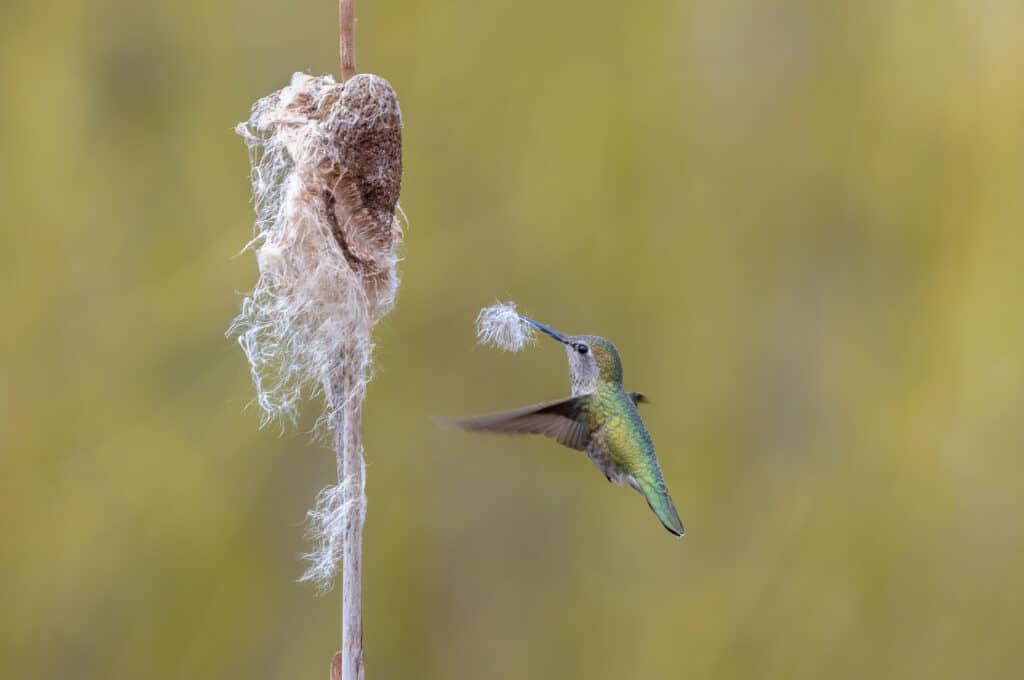
Hummingbirds typically leave Arizona in late summer, or early fall.
©Devonyu /Shutterstock.com
Hummingbirds start their migration from Arizona in late summer or early fall, usually between August and September. The exact timing can vary depending on factors such as weather conditions, food availability, and the species of hummingbird.
Seasonal Patterns:
As the days become cooler and the availability of nectar-rich flowers decreases, hummingbirds instinctively know it’s time to migrate.
Some hummingbird species, like the Anna’s Hummingbird, may stay in Arizona throughout the year, while others, such as the Rufous Hummingbird, are migratory and only visit during certain months.
Long-Distance Travel:
Arizona serves as a crucial stopover for hummingbirds on their epic journey to their wintering grounds.
These incredible travelers may cover thousands of miles, crossing borders and even continents, to reach their final destination in Mexico, Central America, or South America.
Hummingbird Departure in Arizona: Signs to Look Out For
As the vibrant hummingbirds prepare for their migratory journey from Arizona to distant lands, there are telltale signs that can help us anticipate their departure. Here are some of the signs you should look out for:
Decreased Feeder Visits:
One of the first signs that hummingbirds are preparing to leave Arizona is a decrease in their visits to feeders. As natural food sources, such as nectar-rich flowers, dwindle, hummingbirds start relying less on feeders and more on their innate instinct to migrate.
Increased Aggression:
As hummingbirds gear up for their journey, territorial disputes among individuals become more intense.
You may notice more aggressive behavior as hummingbirds fiercely defend their feeding territories, preparing for the long flight ahead.
Flocking Behavior:
Just before departure, hummingbirds often gather in larger groups, forming flocks known as “aggregations.” These aggregations provide safety in numbers and allow hummingbirds to share information about optimal migration routes.
Restless Behavior:
As the departure date approaches, hummingbirds exhibit restless behavior, appearing more anxious and constantly on the move. They may engage in frequent pre-flight exercises, such as hovering and darting, as if testing their wings for the upcoming journey.
Decreased Presence:
As the time draws near, you may notice a decline in hummingbird sightings in your area. This decrease in their presence signifies that they are preparing to bid Arizona farewell and embark on their remarkable migratory voyage.
Native Hummingbird Species Migration in Arizona:
Anna’s Hummingbird:
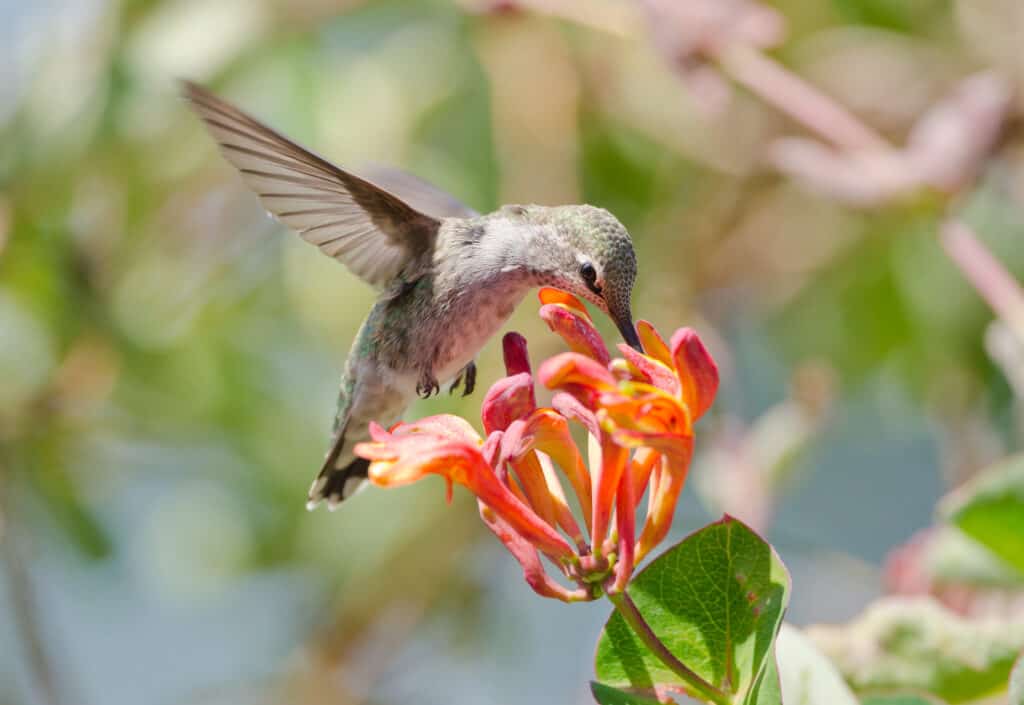
Anna’s hummingbird is a year-round resident in Arizona.
©Birdiegal/Shutterstock.com
The Anna’s Hummingbird is a year-round resident in Arizona, but some individuals undertake short-distance migrations within the state. During the summer months, they can be found nesting in mountains and canyons, but as winter approaches, they move to lower elevations for milder climates.
Black-chinned Hummingbird:

Black-chinned hummingbird is a commonly spotted hummingbird in Arizona.
©rck_953/Shutterstock.com
The Black-chinned Hummingbird is a common summer visitor in Arizona, nesting in woodlands and riparian areas. In the fall, they embark on a lengthy migration to Mexico and Central America, crossing vast distances to reach their wintering grounds.
Costa’s Hummingbird:

Given their small size, the migratory patterns of Costa’s hummingbirds are amazing. They are a common sight in Arizona and the southwestern U.S.
©Takahashi Photography/Shutterstock.com
The Costa’s Hummingbird is a true Arizona native, found exclusively in the southwestern United States and northwestern Mexico. These small but vibrant birds are known for their distinctive purple throat feathers and their preference for desert and scrubland habitats.
Broad-tailed Hummingbird:

Broad-tailed hummingbirds are found in the mountainous regions of Arizona.
©Susan Hodgson/Shutterstock.com
The Broad-tailed Hummingbird is a high-elevation specialist, nesting in mountainous regions of Arizona during the summer months. As winter approaches, they migrate to warmer regions in Mexico, where they join other migratory hummingbird species.
Non-Native Species Of Hummingbirds That Migrate Through The State Of Arizona
While Arizona is home to several native hummingbird species, it also serves as a migratory route for some non-native hummingbirds. These species, although not native to Arizona, undertake remarkable journeys through the state during their annual migrations. Here are a few non-native hummingbird species that migrate through Arizona:
Calliope Hummingbird (Stellula calliope):
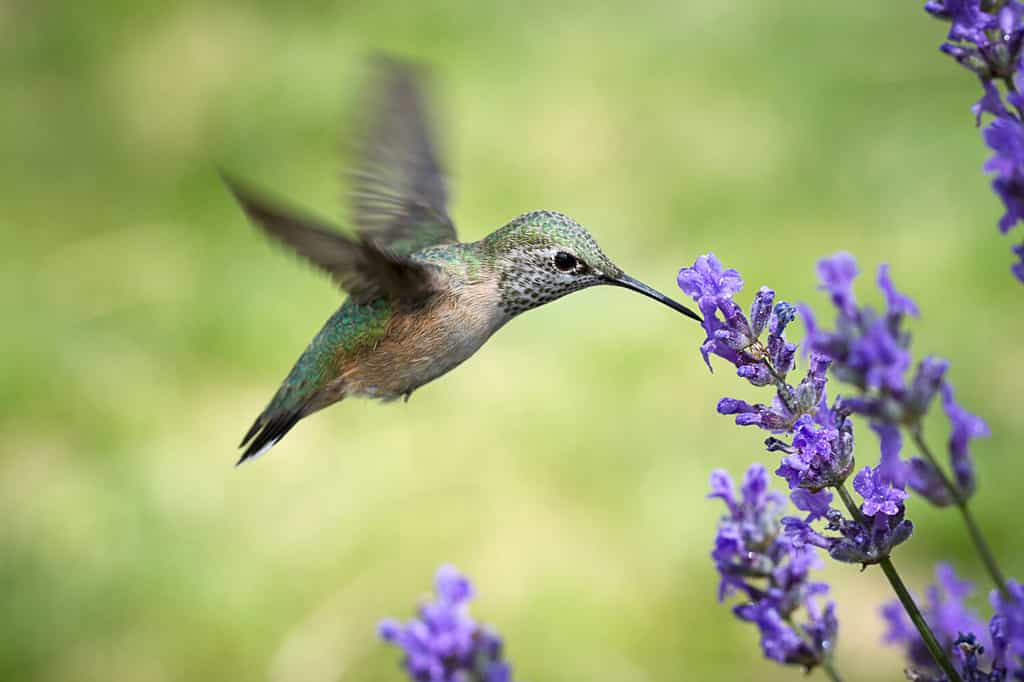
Although not a native species to Arizona, the Calliope hummingbird often passes through Arizona during migration.
©Gregory Johnston/Shutterstock.com
The Calliope Hummingbird is the smallest bird found in North America and breeds in the mountainous regions of western North America. During migration, some individuals pass through Arizona, providing birdwatchers with a rare opportunity to spot this tiny marvel.
Rufous Hummingbird (Selasphorus rufus):
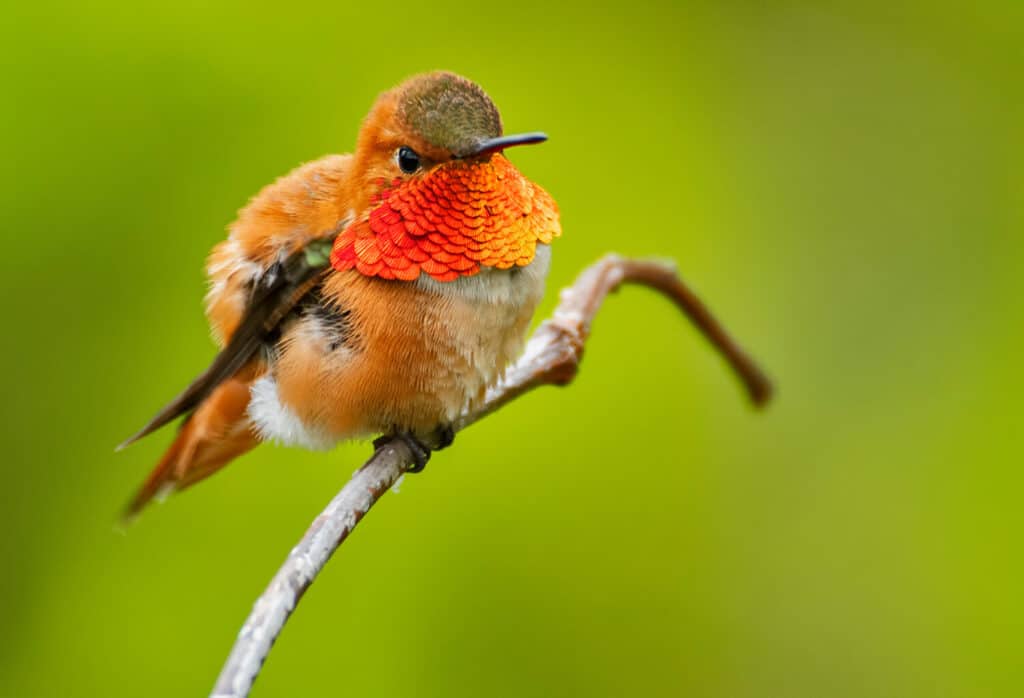
Although not a native species to Arizona, the Rufous hummingbird often passes through Arizona during migration.
©punkbirdr/Shutterstock.com
The Rufous Hummingbird holds the record for the longest migration of any North American hummingbird species. These resilient birds breed in the Pacific Northwest and Alaska and undertake an astounding journey to their wintering grounds in Mexico or even Central America. During their migration, many Rufous Hummingbirds pass through Arizona, delighting bird enthusiasts with their vibrant plumage.
While non-native hummingbird species add to the diversity and excitement of hummingbird watching in Arizona, it is important to note that preserving and maintaining native habitats is crucial for the conservation of both native and migratory hummingbirds.
Are There Any Hummingbirds That Spend The Winter In Arizona?
There are hummingbirds that spend the winter in Arizona. One such species is the Anna’s hummingbird (Calypte anna). Anna’s hummingbirds are year-round residents in Arizona, including during the winter months. They are known for their vibrant colors and can be seen throughout the state, particularly in urban and suburban areas where there are suitable food sources available, such as nectar feeders and flowering plants. These resilient birds have adapted to the winter conditions in Arizona and can survive the colder temperatures by conserving energy and seeking sheltered areas.
Factors Influencing Hummingbird Migration Patterns in Arizona
Hummingbird migration patterns are influenced by several factors, including:
Food Availability:
One of the primary factors influencing hummingbird migration patterns is the availability of food resources. Hummingbirds rely on nectar from flowers as their primary source of energy. They migrate to areas where there is an abundance of flowering plants and nectar-rich food sources. The timing and availability of flowering plants play a crucial role in determining their migration patterns.
Climate and Weather:
Climate and weather conditions also influence hummingbird migration. Hummingbirds are sensitive to temperature changes and may migrate to avoid extreme weather conditions. They tend to follow favorable weather patterns and migrate to areas where temperatures are suitable, and resources are abundant.
Breeding Cycles:
Breeding cycles also affect hummingbird migration patterns. After breeding, some hummingbird species may migrate to different locations to find suitable nesting sites and food sources for their young. The timing of migration may be influenced by the breeding season and the availability of resources needed for successful reproduction.
Genetic Programming:
Genetic programming plays a role in determining the migratory behavior of hummingbirds. Different species have evolved specific migration patterns based on their genetic makeup and inherited traits. These genetic factors can influence the timing, duration, and routes of migration for different hummingbird species.
Environmental Factors:
Other environmental factors such as habitat quality, availability of suitable roosting sites, and the presence of predators can also influence hummingbird migration patterns. Hummingbirds require safe and suitable habitats along their migration routes and may adjust their routes based on the availability of suitable stopover sites.
It’s worth noting that the specific migration patterns of hummingbird species in Arizona can vary depending on the species and their unique ecological requirements.
Hummingbird Migration and the Impact on Arizona’s Ecosystem
Hummingbird migration can have an impact on Arizona’s ecosystem in several ways:
Pollination:
Hummingbirds are important pollinators for many flowering plants. As they migrate through different habitats in Arizona, they visit flowers for nectar, inadvertently transferring pollen from one flower to another. This pollination process is crucial for plant reproduction and contributes to the biodiversity and ecosystem resilience in Arizona.
Seed Dispersal:
Hummingbirds also play a role in seed dispersal. As they feed on the nectar of flowers, they may inadvertently pick up seeds and carry them to different locations. This helps in the dispersal and colonization of plant species in new areas, contributing to the overall diversity and distribution of plants in Arizona’s ecosystem.
Ecosystem Connectivity:
Hummingbird migration helps to connect different ecosystems. As these tiny birds move through various habitats, they facilitate the exchange of genetic material, nutrients, and energy between different plant communities. This connectivity is important for maintaining healthy ecosystems and promoting resilience in the face of environmental changes.
Species Interactions:
Hummingbirds interact with other species in Arizona’s ecosystem. For example, they compete with other nectar-feeding birds and insects for food resources. Their migration patterns can influence the dynamics of these species interactions, affecting population sizes and community structure.
Ecotourism:
Hummingbird migration attracts birdwatchers and nature enthusiasts to Arizona. The presence of diverse hummingbird species and their vibrant displays during migration can contribute to ecotourism and promote local economies through birding tourism.
Where Do Hummingbirds Go When They Leave Arizona?
When hummingbirds leave Arizona, they embark on their migratory journey to various destinations. The specific locations they travel to depend on the species of hummingbird. Here are some general patterns of hummingbird migration:
Northward Migration:
Some hummingbirds that spend the winter in Arizona, such as Anna’s hummingbirds, may migrate northward to breeding grounds in regions like California, Oregon, Washington, and even as far as western Canada.
Central and Eastern North America:
Many hummingbird species that breed in the western United States, including Arizona, undertake long-distance migrations to central and eastern regions of North America. Species like the Black-chinned hummingbird and Broad-tailed hummingbird may travel to states such as New Mexico, Texas, Colorado, and beyond.
Mexico and Central America:
Several hummingbird species that breed in Arizona undertake extensive migrations to Mexico and Central America. These include species like the Rufous hummingbird and Calliope hummingbird, which can travel thousands of miles to reach their wintering grounds in countries like Mexico, Costa Rica, and Panama.
When Do Hummingbirds Return To Arizona?
Hummingbirds typically return to Arizona during their spring migration, which occurs between February and May. The exact timing can vary depending on the species and individual factors. Some hummingbirds start arriving in Arizona as early as February, while others may arrive in April or May.
The arrival of hummingbirds in Arizona is influenced by factors such as food availability, weather conditions, and breeding opportunities. It’s important to note that not all hummingbird species migrate, and some hummingbirds, like the Anna’s hummingbird, can be found in Arizona year-round.
How To Help Hummingbirds When They Return to Arizona
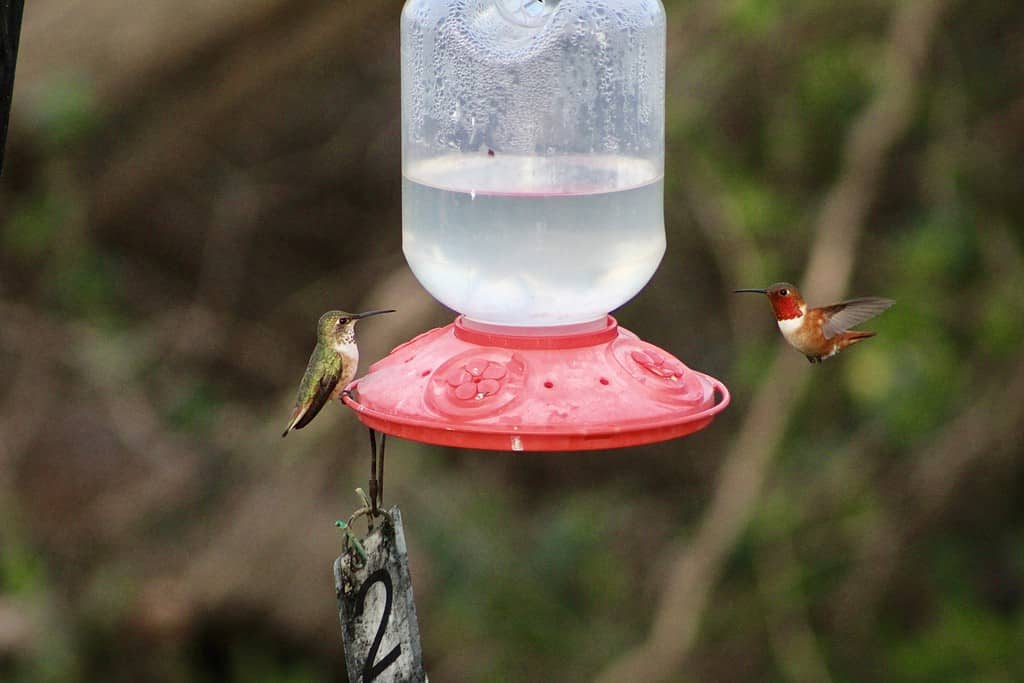
Hummingbird feeders are a great welcome to returning hummingbirds in Arizona.
©Joseph Tointon/iStock via Getty Images
When hummingbirds return to Arizona, there are several ways you can help create a welcoming environment for them:
Provide Food:
Place hummingbird feeders filled with a solution of four parts water to one part white granulated sugar. Avoid using honey or artificial sweeteners. Hang the feeders in a shaded area to prevent the nectar from spoiling quickly. Clean and refill the feeders regularly, especially during hot weather.
Plant Native Flowers:
Create a hummingbird-friendly garden by planting native flowering plants that provide nectar. Some examples include desert honeysuckle, penstemon, fairy duster, and ocotillo. These plants not only provide a natural food source but also attract insects, another important part of a hummingbird’s diet.
Offer Shelter:
Hummingbirds need places to rest and hide. Planting trees, shrubs, and vines can provide shade, perches, and nesting opportunities for them. Native plants with dense foliage can serve as natural shelter and protect the birds from predators.
Avoid Pesticides:
Minimize or avoid the use of pesticides in your garden, as these can be harmful to hummingbirds and other pollinators. Opt for natural pest control methods or choose plants that are naturally resistant to pests.
Provide Water:
Hummingbirds need water for drinking and bathing. Providing a shallow birdbath or a mister can attract them. Make sure to keep the water fresh and clean.
Maintain a Safe Environment:
Keep your cats indoors and prevent window collisions by placing decals or stickers on windows to make them more visible to the birds.
The photo featured at the top of this post is © iStock.com/Jedlovec
Thank you for reading! Have some feedback for us? Contact the AZ Animals editorial team.







